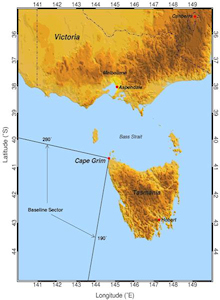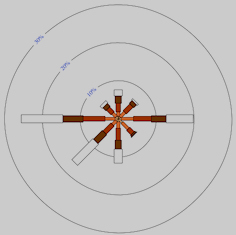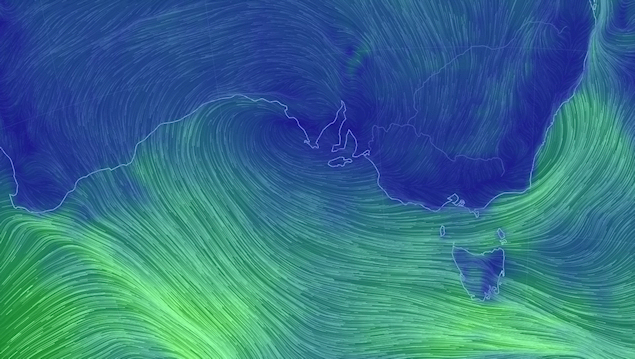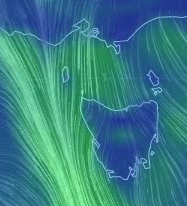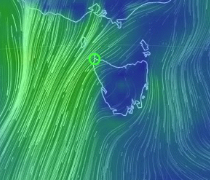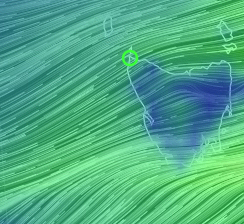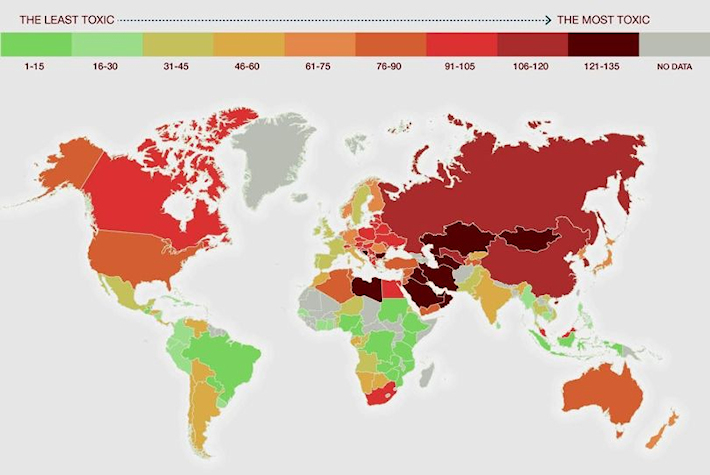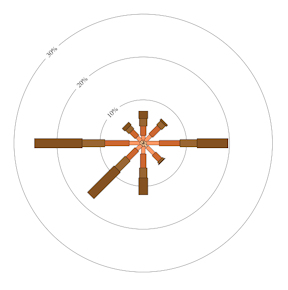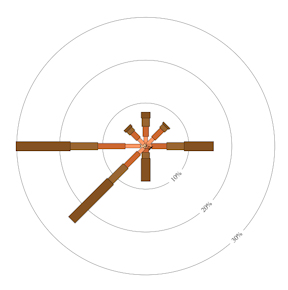
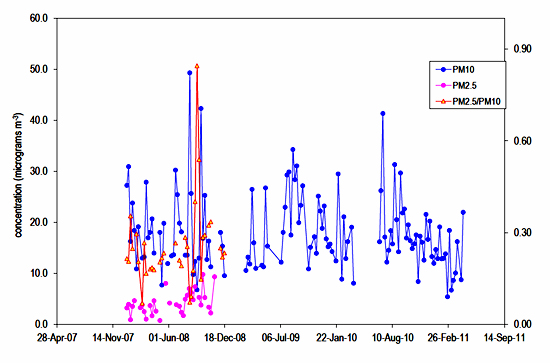
The Cape Grim Baseline Air Pollution Station was established in 1976 to monitor and study global atmospheric composition.You can read about it here.
The Station's scientific research is jointly managed by the Bureau of Meteorology and Commonwealth Scientific and Industrial Research Organisation (CSIRO) - Marine and Atmospheric Research. Other Australian and international research institutions contribute.
The Bureau funds and manages the station and liaises with the World Meteorological Organization and the United Nations Environment Programme.
Station management, lead scientists and other specialists give advice on the overall program. Lead scientists manage individual scientific programs.
One of the core scientific programs conducted at Cape Grim is PARTICULATES, i.e., Pm10 and PM2.5.
Particulates get a mention here http://www.bom.gov.au/inside/cgbaps/programs.shtml
If, “Pollution threatens environmental sustainability and can have harmful effects on human health.” then why has the PM2.5 baseline air monitor at Cape Grim been out of action since it stopped operating in December 2008 for some years?
The Station's scientific research is jointly managed by the Bureau of Meteorology and Commonwealth Scientific and Industrial Research Organisation (CSIRO) - Marine and Atmospheric Research. Other Australian and international research institutions contribute.
The Bureau funds and manages the station and liaises with the World Meteorological Organization and the United Nations Environment Programme.
Station management, lead scientists and other specialists give advice on the overall program. Lead scientists manage individual scientific programs.
One of the core scientific programs conducted at Cape Grim is PARTICULATES, i.e., Pm10 and PM2.5.
Particulates get a mention here http://www.bom.gov.au/inside/cgbaps/programs.shtml
If, “Pollution threatens environmental sustainability and can have harmful effects on human health.” then why has the PM2.5 baseline air monitor at Cape Grim been out of action since it stopped operating in December 2008 for some years?
"PM2.5 samples collected with LV that stopped operating in Decenber 2008, ...due to some sampling issues we had."
Scientists from around the world supposedly rely on data gathered at Cape Grim monitoring station. We are told governments make decisions based on data from Cape Grim. How can they, and what are these people being told?
We should not have been claiming Tasmania’s N/W tip has the cleanest air in the world (see below)when PM2.5 data was not been gathered from the Cape Grim monitoring station from 2008- 2011+
We should not have been claiming Tasmania’s N/W tip has the cleanest air in the world (see below)when PM2.5 data was not been gathered from the Cape Grim monitoring station from 2008- 2011+
Smoke comes into Tasmania from the mainland.
Here in the right hand picture it can be seen entering the measuring segment of the Cape Grim base-line air monitoring station. It fails to be recorded when the PM2.5 measuring equipment is not working or the segment switch is turned off.
Cape Grim monitoring station can claim "This baseline air is representative of a large area of the Southern Hemisphere, unaffected by regional pollution sources (there are no nearby cities or industry that would contaminate the air quality)."
But it is not representative of Tasmania's air quality, just the ocean's, because winds coming into this sector occur only about 35 % of the time.
Here in the right hand picture it can be seen entering the measuring segment of the Cape Grim base-line air monitoring station. It fails to be recorded when the PM2.5 measuring equipment is not working or the segment switch is turned off.
Cape Grim monitoring station can claim "This baseline air is representative of a large area of the Southern Hemisphere, unaffected by regional pollution sources (there are no nearby cities or industry that would contaminate the air quality)."
But it is not representative of Tasmania's air quality, just the ocean's, because winds coming into this sector occur only about 35 % of the time.
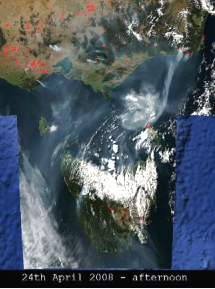
Image from EPA Technical
Report #9, page 59.
Report #9, page 59.
Courtesy Google maps
Smoke consists primarily of fine particle pollution (PM2.5).
It is widely reported that this size particle can travel deep into the lungs and stay there. These particulates can have aerosols or other gaseous toxins attached to them and they can cross over into the blood stream.
It is interesting to note the PM2.5 air monitoring at Cape Grim went out of action at much the same time in 2008 as Tasmanians were subjected to horrendous quantities of pernicious forestry smoke. The smoke has persisted while the Cape Grim PM2.5 air monitor was not reporting. (see 18/5/2012 comment below). Right to Information was used to find out what was going on.
It is widely reported that this size particle can travel deep into the lungs and stay there. These particulates can have aerosols or other gaseous toxins attached to them and they can cross over into the blood stream.
It is interesting to note the PM2.5 air monitoring at Cape Grim went out of action at much the same time in 2008 as Tasmanians were subjected to horrendous quantities of pernicious forestry smoke. The smoke has persisted while the Cape Grim PM2.5 air monitor was not reporting. (see 18/5/2012 comment below). Right to Information was used to find out what was going on.
Cape Grim stopped monitoring PM2.5's in 2008. Graph provided by the CSIRO
You do not need to go to Linfen, China; Tasmania can be one of the filthiest paces on earth when forestry are burning their waste, when people are back-yard burning or have their wood heaters going, or there is pollution coming in from the mainland.
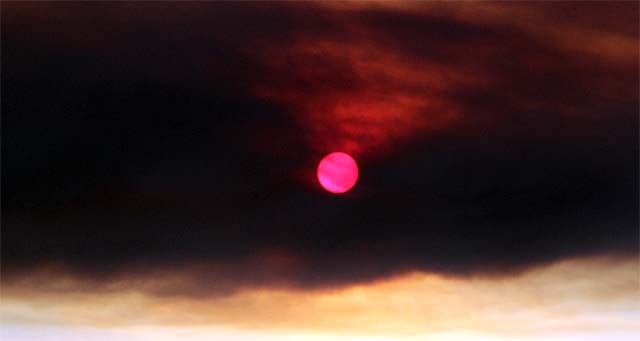
Smoke obscures the setting sun last night. Picture: LEIGH WINBURN

Senate Question # 1854
Senator Milne asked the Minister in writing on 18/5/2012.
2. When will the PM2.5 Cape Grim Baseline Air Pollution Station be reinstated and resume monitoring?
Senator Conroy: The Minister for Sustainability, Environment, Water, Population and Communities provided the following answer;
2. Cape Grim is currently monitoring PM2.5 and will continue to do so as part of the aerosol program.
Senator Milne asked the Minister in writing on 18/5/2012.
2. When will the PM2.5 Cape Grim Baseline Air Pollution Station be reinstated and resume monitoring?
Senator Conroy: The Minister for Sustainability, Environment, Water, Population and Communities provided the following answer;
2. Cape Grim is currently monitoring PM2.5 and will continue to do so as part of the aerosol program.
Cape Grim measuring sector.
Click to enlarge.
The PM sensor switch turns off when wind blows from outside the 190-280 degrees baseline sector.
Click to enlarge.
The PM sensor switch turns off when wind blows from outside the 190-280 degrees baseline sector.

Cape Grim Base-line Air Monitoring Station
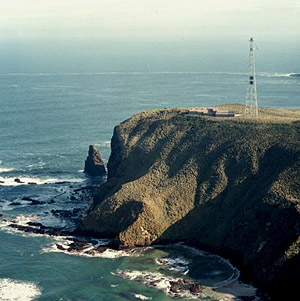
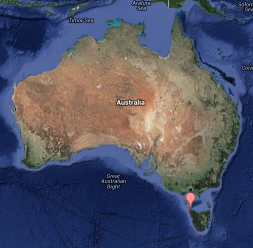
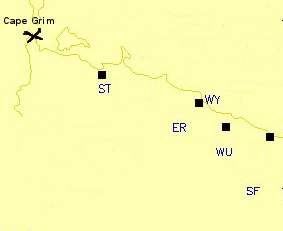
The ambient air monitoring station provided by EPA Air Tasmania at Smithton (ST) is about 8Km down wind from Cape Grim Base-line air monitoring station and records PM that is certainly not the cleanest air in the world.
People in Tasmania certainly are not breathing the cleanest air in the world with the dirty burning that goes on in our beautiful state, and the further you travel from Cape Grim the worse it gets.
For example check out the photos here.
People in Tasmania certainly are not breathing the cleanest air in the world with the dirty burning that goes on in our beautiful state, and the further you travel from Cape Grim the worse it gets.
For example check out the photos here.
"Despite what we might think about Tasmania, our air quality is not always the best. In fact, during winter parts of Tasmania have some of the dirtiest air in Australia." - Aurora Energy.
Go HERE: Aurora was formed by the disaggregation of the Tasmanian Hydro Electric Commission (HEC) on 1 July 1998. Formed under the Electricity Companies Act 1997, Aurora is subject to the Corporations Act 2001. The company is wholly owned by the Government of Tasmania, with its two shareholders being the Minister for Energy and Resources, and the Treasurer.
Go HERE: Aurora was formed by the disaggregation of the Tasmanian Hydro Electric Commission (HEC) on 1 July 1998. Formed under the Electricity Companies Act 1997, Aurora is subject to the Corporations Act 2001. The company is wholly owned by the Government of Tasmania, with its two shareholders being the Minister for Energy and Resources, and the Treasurer.
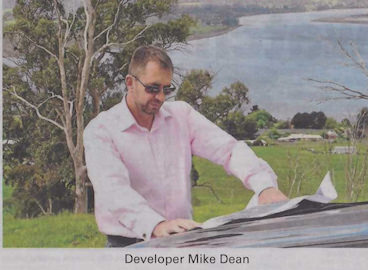
Mr. Mike Dean, Tasmanian developer, took out a full page advertisement in the Sunday Examiner, February 23, 2014 which included the above photo.
He claimed, "...visitors...can enjoy what we do too, like;
The world's purest air. The purest water. The safest environment."
We need to remember this development was to be at Grindelwald, near Launceston in the Tamar valley that is prone to temperature inversions. It is nowhere near Cape Grim base-line air monitoring station, is downwind from Cape Grim and the air will have picked up pollution.
A letter was written to the newspaper Editor as follows on the 25th February:
We in Tasmania do not enjoy the world’s purest air or water. Aurora Energy is on record as saying, “Despite what we might think about Tasmania, our air quality is not always the best. In fact during winter parts of Tasmania have some of the dirtiest air in Australia.”
And during autumn when forestry is burning our air quality can degrade severely.
In summer we get smoke from fires in Tasmania and the mainland.
Cape Grim claims to have the cleanest air in the world because the air being monitored only comes from the Great Southern Ocean. The monitoring switch is turned off if air enters from outside that measuring quadrant (http://cleanairtas.com/air-monitoring/cape-grim.html). Most people don’t live at Cape Grim or on the ocean.
Their clean air is soon fouled as confirmed by an air monitoring station at Smithton a short distance away. We certainly don’t enjoy the world’s purest air.
And for purest water, the Rubicon River had a MCPA reading of 19.1 in January!
The Liberals are blind to the developer’s claims and have promised $3.4million for the Craggy Ridge eco health development but they too want an unhealthy stinking pulp mill just across the river from it. Tell this to the eco investors.
I wish Liberal would make their mind up, health or pulp mill.
Footnote: Craggy Ridge ecotourism turned into a 15 lot subdivision. Re the pulp mill go HERE
He claimed, "...visitors...can enjoy what we do too, like;
The world's purest air. The purest water. The safest environment."
We need to remember this development was to be at Grindelwald, near Launceston in the Tamar valley that is prone to temperature inversions. It is nowhere near Cape Grim base-line air monitoring station, is downwind from Cape Grim and the air will have picked up pollution.
A letter was written to the newspaper Editor as follows on the 25th February:
We in Tasmania do not enjoy the world’s purest air or water. Aurora Energy is on record as saying, “Despite what we might think about Tasmania, our air quality is not always the best. In fact during winter parts of Tasmania have some of the dirtiest air in Australia.”
And during autumn when forestry is burning our air quality can degrade severely.
In summer we get smoke from fires in Tasmania and the mainland.
Cape Grim claims to have the cleanest air in the world because the air being monitored only comes from the Great Southern Ocean. The monitoring switch is turned off if air enters from outside that measuring quadrant (http://cleanairtas.com/air-monitoring/cape-grim.html). Most people don’t live at Cape Grim or on the ocean.
Their clean air is soon fouled as confirmed by an air monitoring station at Smithton a short distance away. We certainly don’t enjoy the world’s purest air.
And for purest water, the Rubicon River had a MCPA reading of 19.1 in January!
The Liberals are blind to the developer’s claims and have promised $3.4million for the Craggy Ridge eco health development but they too want an unhealthy stinking pulp mill just across the river from it. Tell this to the eco investors.
I wish Liberal would make their mind up, health or pulp mill.
Footnote: Craggy Ridge ecotourism turned into a 15 lot subdivision. Re the pulp mill go HERE
Cradle Coast NRM says we have the cleanest air in the world at Cape Grim.
Then they add, "... as this air moves across Tasmania it is impacted by activities that reduce air quality."
Read their fact sheet here
Then they add, "... as this air moves across Tasmania it is impacted by activities that reduce air quality."
Read their fact sheet here
Forestry Tasmania lit these burns (green dots) in the N/W of Tasmania on the 8th April 2015.
Cape Grim cannot be seen in this NASA aqua modis satelite image at 14.25 AEST because of the smoke.
Cleanest air in the world at Cape Grim?
Cape Grim cannot be seen in this NASA aqua modis satelite image at 14.25 AEST because of the smoke.
Cleanest air in the world at Cape Grim?
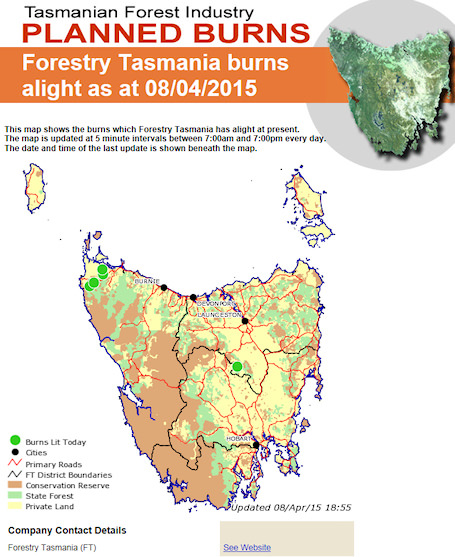
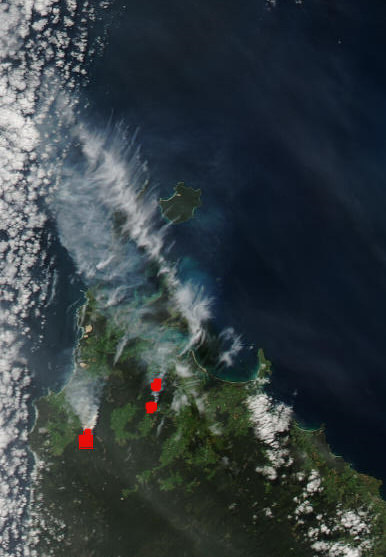
Cape Grim Wind Roses
To enlarge click on the wind roses supplied by the Bureau of Meterology / CSIRO.
Not only does wind come into Cape Grim from the Great Southern Ocean it comes in from other not-so-clean directions as well.
To enlarge click on the wind roses supplied by the Bureau of Meterology / CSIRO.
Not only does wind come into Cape Grim from the Great Southern Ocean it comes in from other not-so-clean directions as well.
Screen shots of live wind animations.
Thanks to http://earth.nullschool.net/#current/wind/surface/level/orthographic=146.14,-39.70,2151
Check out the above link to see where our air is actually coming from.
The air does not always come from the Southern Ocean as claimed but can come from mainland Australia, or even from across Tasmania.
You can see on these occassions the air has not reached Cape Grim from the Southern Ocean.
Thanks to http://earth.nullschool.net/#current/wind/surface/level/orthographic=146.14,-39.70,2151
Check out the above link to see where our air is actually coming from.
The air does not always come from the Southern Ocean as claimed but can come from mainland Australia, or even from across Tasmania.
You can see on these occassions the air has not reached Cape Grim from the Southern Ocean.
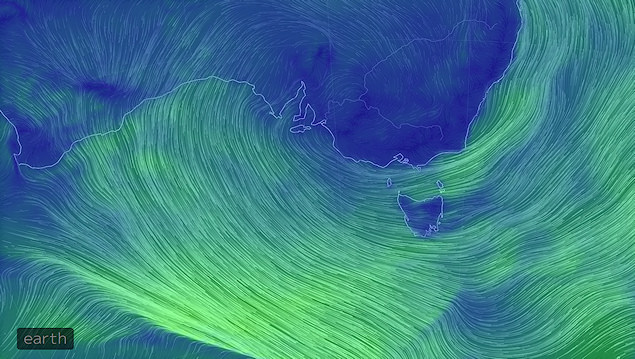
Following on, here is another image from about a month later.
The PM segment switch (see above) could have been turned on because air was being measured
coming into the Cape Grim measuring sector.
But really where is our weather coming from and what are we measuring at Cape Grim?
The air being measured at Cape Grim base-line monitoring station is not what most Tasmanians are
breathing.
According to the CSIRO :
“The Cape Grim station is positioned just south of the isolated north-west tip (Woolnorth Point) of
Tasmania. It is in an important site, as the air sampled arrives at Cape Grim after long trajectories over
the Southern Ocean, under conditions described as ‘baseline’. This baseline air is representative of a
large area of the Southern Hemisphere, unaffected by regional pollution sources (there are no nearby
cities or industry that would contaminate the air quality).”
If you look at the two wind screen-shots above, it can be seen the air is not always coming unpolluted
from the direction of the Great Southern Ocean into Tasmania as claimed but can come to Cape Grim
and other parts of Tasmania after travelling across mainland Australia land mass picking up whatever
pollutants along the way.
Particulate matter in the form of dust and smoke particulates have been documented coming into
Tasmania from the mainland.
It seems time for a rethink on this ‘Cape Grim cleanest, purest, air in the world’ thing.
Do we go by an artist's snapshot when she visited Tasmania or do we go by what people have to say
that actually live here?
Do we go by the other snapshots, in the form of 'controlled' air samples gathered under base-line
conditions and stored in canisters at Cape Grim station, or do we go by the air that all living things are
required to breathe day in and day out in Tasmania, including those at Cape Grim?
To repeat, the air at Cape Grim monitoring station is not what most Tasmanians are breathing. It is not
representative of our ambient air quality across Tasmania. It has been gathered under base-line
conditions...sometimes.
We do not live at the air intake at Cape Grim monitoring station where these cleanest air samples in
the world are selectively gathered, and we do not live on the Southern Ocean.
It is claimed by some that Cape Grim (monitoring station) has the world’s purest air, but this is not the
case all of the time and Cape Grim (monitoring station) is not Tasmania.
Take for example Cape Grim Beef.
Cape Grim in the far northwest corner, shaped by wild Southern Ocean swells, abundant
rainfall, has the cleanest air in the world.
However, this link is purely to a photographer’s personal work in the name of Angela Palmer, the same
person mentioned in the Guardian Unlimited article at the top of the page. (Angela Palmer observed
that local people do not appear to appreciate living in the cleanest place in the world. Perhaps it is
because it could be the cleanest part of the world, but is not because of all the deliberate unnecessary
burning that goes on in this state. on the islands and on the mainland. And people are being told to
lock themselves in their houses by our Health Department). Angela makes a very valid point about
children breathing pollution day in a day out; something which cleanairtas has consistently said about
Tasmania's ambient air quality.
On the beef About page, “Cape Grim is on the north-western most tip of the Tasmanian mainland and
hosts the world's most pure air.
Tasmania is renowned for its pristine wilderness but you might not know it’s home to the purest air on
earth.
[Cape Grim monitoring station has been cited as having the worlds purest air; not Tasmania.]
In the North-Western corner of Tasmania 40° 41' South, those world-famous Roaring Forties whip
away any trace of pollution as they blow across the Southern Ocean. Combined with low levels of
development and its sheer distance from other land landmasses, Cape Grim’s air quality is pretty
unique ..."
Then on the Our difference page it mentions The Purest Air in the World.
On the Our Farmers page we are told, “You can drive all around Tasmania and see Cape Grim
signs on farm gates”
This is the point. There are claimed to be 800 Cape Grim Beef farmers scattered around
mainland Tasmania and on the islands. Actually scattered around Tasmania and the islands,
not actually grazing where base-line air is actually measured at Cape Grim base-line air
monitoring station.
At other places on this website you can see a lot of these cattle would not be living and
breathing the cleanest, purest, air in the world.
They would be breathing, eating and drinking life's essentials that are contaminated by mostly
deliberate unnecessary wood burning, the same as we are.
ABOUT AUSTRALIA - website Facts about Tasmania
“Encircled by the Southern Ocean, Tasman Sea and Bass Strait, we breathe the world’s cleanest air….”
After looking at information and photos on this site at http://www.cleanairtas.com you would have to agree we do not breathe the world's cleanest air in Tasmania. We breathe some of the dirtiest air at times.
11th August 2015 - After a complaint this statement was changed to read, "Encircled by the Southern Ocean, Tasman Sea and Bass Strait, Tasmanians breathe clean air..." At times!
“Encircled by the Southern Ocean, Tasman Sea and Bass Strait, we breathe the world’s cleanest air….”
After looking at information and photos on this site at http://www.cleanairtas.com you would have to agree we do not breathe the world's cleanest air in Tasmania. We breathe some of the dirtiest air at times.
11th August 2015 - After a complaint this statement was changed to read, "Encircled by the Southern Ocean, Tasman Sea and Bass Strait, Tasmanians breathe clean air..." At times!
CAPE GRIM Water - off the market
"Cape Grim is located North of Antarctica and SOMETIMES receives air that has travelled 16,000 kilometres across nothing but the freezing Antarctic Ocean./..."
Whilst it is true some air entering Cape Grim,"... has travelled 16000 Km across nothing but the freezing Antartic Ocean" there are many times the air coming into Cape Grim does not meet this basic baseline condition.
It can have travelled across land from mainland Australia just a short distance away, or from across Tasmania itself. See the wind rose above.
Remember, the Cape Grim measuring switch is turned off if air arrives outside the 190 to 280 degrees segment because it does not meet base-line conditions. By observation this happens VERY often!
Watch the short videos below from nullschool.net:
"Cape Grim is located North of Antarctica and SOMETIMES receives air that has travelled 16,000 kilometres across nothing but the freezing Antarctic Ocean./..."
Whilst it is true some air entering Cape Grim,"... has travelled 16000 Km across nothing but the freezing Antartic Ocean" there are many times the air coming into Cape Grim does not meet this basic baseline condition.
It can have travelled across land from mainland Australia just a short distance away, or from across Tasmania itself. See the wind rose above.
Remember, the Cape Grim measuring switch is turned off if air arrives outside the 190 to 280 degrees segment because it does not meet base-line conditions. By observation this happens VERY often!
Watch the short videos below from nullschool.net:
To recap:
At Cape Grim Baseline Air Monitoring Station, according to the CSIRO, baseline time (BL) is the time the air samplers are actually running.
The samplers are connected to a baseline switch and samples are taken only during baseline conditions.
The main condition for baseline is that the wind direction is between 190 and 280 degrees. This is only about 35% of the time.
Air can enter the measuring segment but on a great many occassions it has not come come from Antarctica or great distances across the Southern Ocean.
No sampling is done during non-baseline conditions so the mass on the filters is claimed to be made up purely from marine sources.
This is the only time when Cape Grim monitoring station should be monitoring the cleanest air in the world, and even this ‘purest’ air soon gets polluted after it is monitored.
Southern-hemisphere-joins-north-in-breaching-carbon-dioxide-milestone.
The other 270 degrees of air coming into Cape Grim monitoring station is not classed as baseline and does not lend itself to be so loosely referred to as the cleanest/purest air in the world.
We cannot just latch onto 90 degrees of baseline air measured sometimes under baseline conditions at Cape Grim to say we breathe the cleanest/purest air in the world. These statements are simply not correct.
Baseline air quality from the Southern Ocean is not representative of Tasmanian air quality.
At Cape Grim Baseline Air Monitoring Station, according to the CSIRO, baseline time (BL) is the time the air samplers are actually running.
The samplers are connected to a baseline switch and samples are taken only during baseline conditions.
The main condition for baseline is that the wind direction is between 190 and 280 degrees. This is only about 35% of the time.
Air can enter the measuring segment but on a great many occassions it has not come come from Antarctica or great distances across the Southern Ocean.
No sampling is done during non-baseline conditions so the mass on the filters is claimed to be made up purely from marine sources.
This is the only time when Cape Grim monitoring station should be monitoring the cleanest air in the world, and even this ‘purest’ air soon gets polluted after it is monitored.
Southern-hemisphere-joins-north-in-breaching-carbon-dioxide-milestone.
The other 270 degrees of air coming into Cape Grim monitoring station is not classed as baseline and does not lend itself to be so loosely referred to as the cleanest/purest air in the world.
We cannot just latch onto 90 degrees of baseline air measured sometimes under baseline conditions at Cape Grim to say we breathe the cleanest/purest air in the world. These statements are simply not correct.
Baseline air quality from the Southern Ocean is not representative of Tasmanian air quality.
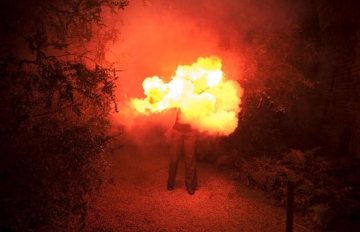
Would people need to demonstrate by letting off smoke flares if we breathe the cleanest or purest air in the world?
Go HERE to read the story.
Go HERE to read the story.
Clean-Air Credentials: “The air in Tasmania is as clean as it is in Antarctica,” says Paul Fraser, an expert in ozone and climate change from Australia’s Commonwealth Scientific and Industrial Research Organisation - CSIRO. “If you go further south in the Southern Hemisphere, the background concentrations of pollutants don’t change much.”
The baseline air measured at Cape Grim Baseline air monitoring station might be as clean as it is in Antarctica, but it should not be claimed the air in Tasmania is as clean as it is in Antarctica.
Most Tasmanians do not breathe baseline air, we do not breathe the world’s purest air; at times we mostly breathe air that has been polluted by woodsmoke.
The baseline air measured at Cape Grim Baseline air monitoring station might be as clean as it is in Antarctica, but it should not be claimed the air in Tasmania is as clean as it is in Antarctica.
Most Tasmanians do not breathe baseline air, we do not breathe the world’s purest air; at times we mostly breathe air that has been polluted by woodsmoke.
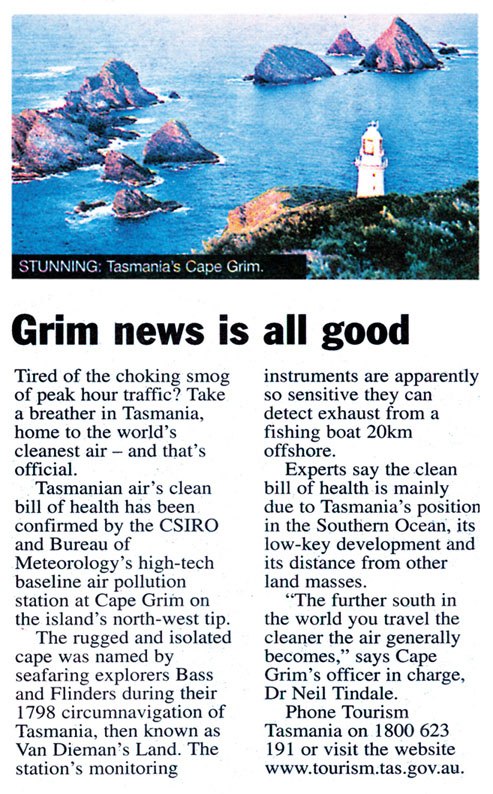
Here it is again and it is stunning!
No, Tasmania's air is not stunning and this has been determined by those who are forced to breathe it.
What is stunning are the claims being made below by Tourism Tasmania.
In fact Cape Grim does not have a lighthouse (there are no lighthouses anywhere near Cape Grim according to the Admiralty list of Lights and Foghorns Vol K which covers Oceania).
The glossy photograph Tourism Tasmania has used is of Maatsuyker Island lighthouse which is nowhere near Cape Grim!
This is a government department promoting Tasmania in a manner that is obviously wrong.
No, Tasmania's air is not stunning and this has been determined by those who are forced to breathe it.
What is stunning are the claims being made below by Tourism Tasmania.
In fact Cape Grim does not have a lighthouse (there are no lighthouses anywhere near Cape Grim according to the Admiralty list of Lights and Foghorns Vol K which covers Oceania).
The glossy photograph Tourism Tasmania has used is of Maatsuyker Island lighthouse which is nowhere near Cape Grim!
This is a government department promoting Tasmania in a manner that is obviously wrong.
Do we in Tasmania breathe the cleaneast air in the world? Hardly.
3.2. 2017 - Kenya ranked country with cleanest air in the world
Diaspora Messenger
Kenya has been ranked the country with the cleanest air in the World, topping a list that considered air pollution, energy consumption and renewable energy production.
Data used to rank the countries was obtained from the International Energy Agency and the World Health Organization. It was used by renewable energy firm The Eco Experts to rank the most toxic countries in the world.
Diaspora Messenger
Kenya has been ranked the country with the cleanest air in the World, topping a list that considered air pollution, energy consumption and renewable energy production.
Data used to rank the countries was obtained from the International Energy Agency and the World Health Organization. It was used by renewable energy firm The Eco Experts to rank the most toxic countries in the world.
Map by Eco Experts
Click on map to enlage South East Asia and Australia
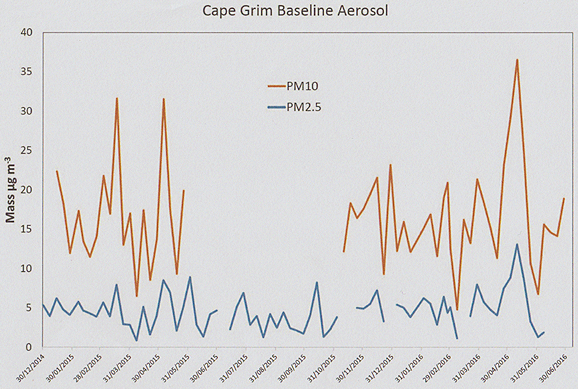
9am September 2010
9am August 2019
3pm August 2019
PM2.5 and PM10 readings at Cape Grim for 2015 to 2019.
Samples are only collected when the switch is turned on during 190 - 280 degree air coming into the monitor. This is only about 35% of the time.
Samples are only collected when the switch is turned on during 190 - 280 degree air coming into the monitor. This is only about 35% of the time.
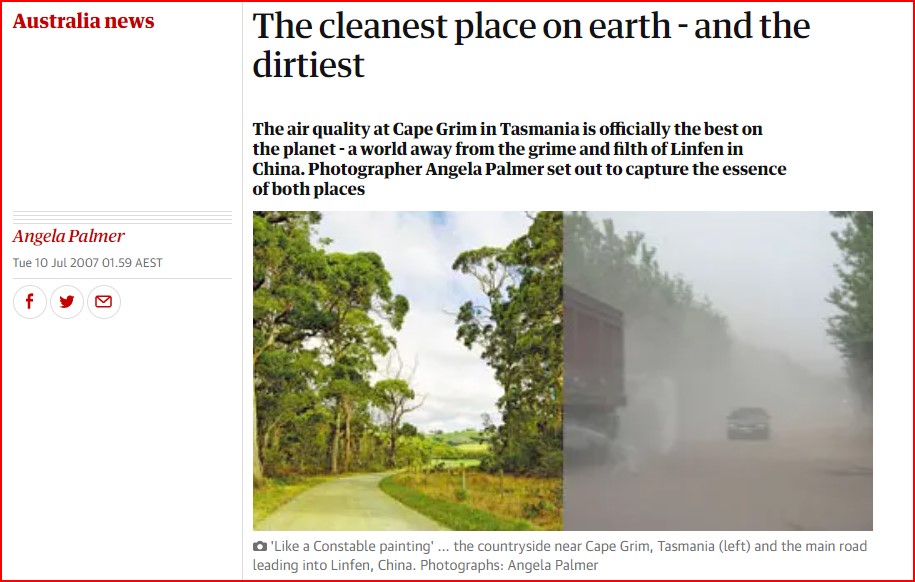
Advance to 2013 - We get pretty much the same thing
"A picturesque island with the cleanest air on earth"
Go HERE to read how some Tasmanians see it
"A picturesque island with the cleanest air on earth"
Go HERE to read how some Tasmanians see it
